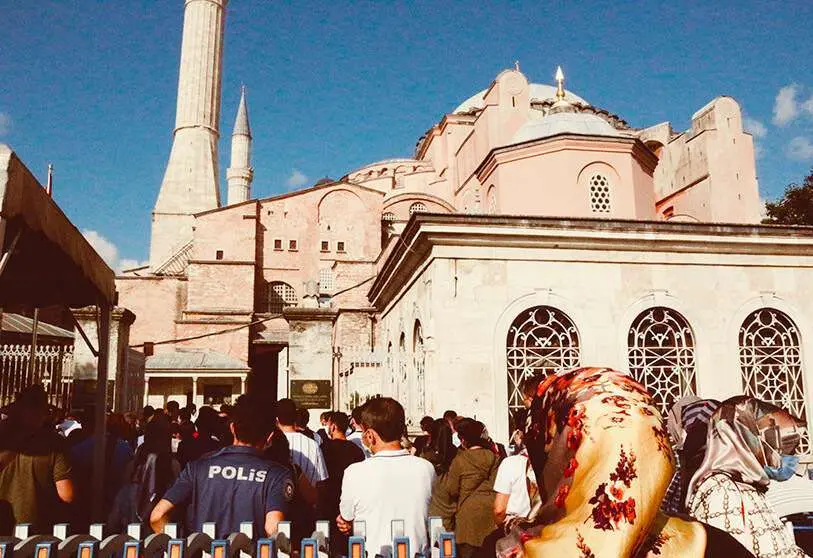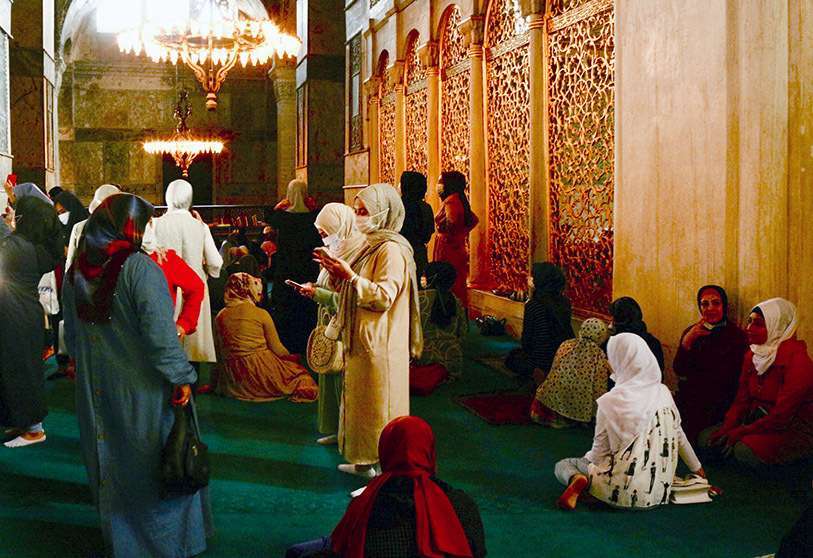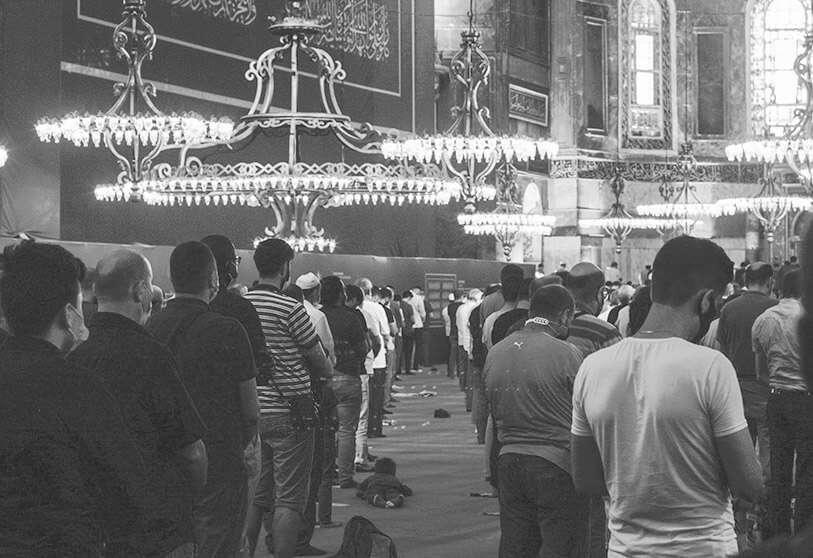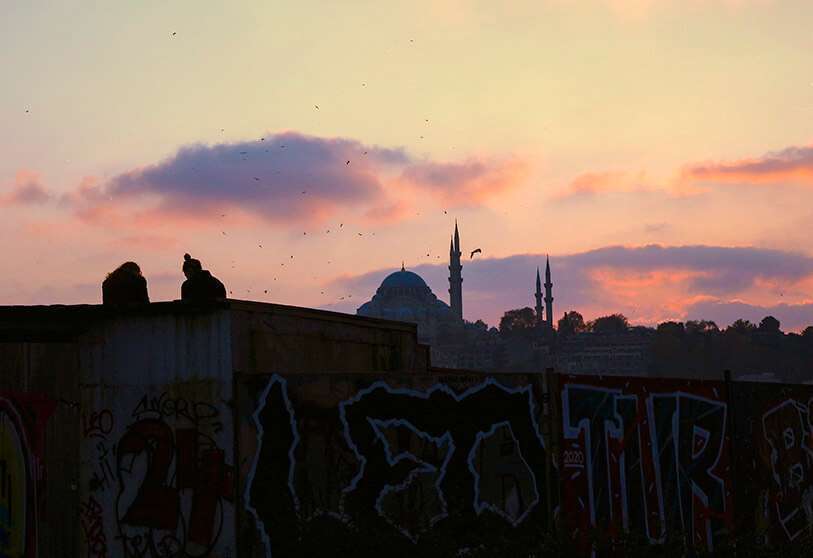The new generations against Hagia Sophia for the control of Istanbul

Hagia Sophia, one of Turkey's landmarks, is no longer what it used to be. Six months ago, the current government of this country, led by the Justice and Development Party (AKP), decreed the conversion of what was the Ayasofya (its name in Turkish) Museum into a mosque, as it was 83 years ago. These reforms, which were made to please the most conservative people, have served little against the new generations that are fighting to change the current situation of the country.
Hagia Sophia, famous for its 55-metre-high dome, was built in the year 360 as the Byzantine Orthodox Cathedral of Constantinople, and has been passed down from hand to hand, or from religion to religion until it was turned into a museum. Since then, it was considered the tourist attraction of Istanbul par excellence. Until a little over six months ago, when you entered Hagia Sophia you could see how three religions (Orthodox Church, Christianity and Islam) lived together in harmony. From the reddish exterior, with four minarets surrounding its dome, this building could pass for a mosque, as it had done only 80 years earlier. However, when you entered, you did not have to take off your shoes or cover yourself. Muslim elements such as the Şadırvan (fountain where the faithful wash before entering the prayer) only served as part of its architecture, which gave it an Islamic beauty. Upon entering, low lamps, also typical of mosques, illuminated the room; a dimly lit room where mosaics, lights, paintings and all sorts of elements from these three religions rested. They were worn out by time. In the centre, just below the central dome, you can see the Byzantine mosaic representing the Virgin Mary with the Child Jesus resting next to the ornaments representing Allah and Muhammad typical of Islam.

Hagia Sophia (as it was baptised when it was built) could be considered a reflection of what Turkey, in question, is and has always been: a bridge between cultures. That is what you felt when you entered; that religions could live in harmony, as Turkey had been demonstrating since it was Constantinople. Saint Sophia was an Orthodox Church due to the influence of the Byzantine Empire, to become allied with the Crusaders and to be transformed into a Catholic Church. Faithful to history and showing the hegemony of the Ottoman Empire in the 15th century it became a mosque. And it did not remain behind with the establishment of the Turkish Republic; Ayasofya, following the precepts of Ataturk and the secularisation of the country, was consolidated as a museum. Chapter after chapter, being the best book of Turkish history, it now has a new page.
On July 10th last year, the conversion of this museum into a mosque was approved, once again highlighting the future of the Republic and reopening the debate on the Islamisation of the country. Recep Tayyip Erdogan, the president of the country and leader of the AKP, declared at that time that "It is the product of the same logic to demand the Vatican be converted into a museum and insist that Hagia Sophia remain as a museum," while promising that "Hagia Sophia which is the common heritage of humanity is going to continue to embrace everyone with its new status, in a much more sincere and much more original way."

Now, at the entrance to Hagia Sophia, people are crowding into the prayer area, skipping the safety distance necessary in times of pandemic. Only a mandatory mask and no capacity limit. If you are a woman, you must cover your head and if you are a man, it is forbidden to leave your legs uncovered. In the courtyard, before entering the building, the previously empty Şadırvan is the first stop for the faithful, where the water now runs and everyone bends down to wash their hands and feet, and thus purify themselves before prayer.
Once inside, the first thing that stands out is a white cloth that covers the Byzantine era mosaics that adorn that first entrance corridor. Before entering the central area, now the prayer area, you should take off your shoes and leave them in the drawers placed at the sides of the doors. Women can only enter through the door on the right and must stay in that room. The floors are now covered with carpets, but this is not the only thing covered; a large burgundy cloth with gilded embroidery in Arabic covers all non-Islamic elements. A wooden fence separates the prayer room into two rooms, and through this fence families or couples can communicate or take pictures as best they can. Tourists or believers all follow the same protocol. This is the protocol of a mosque, which makes it difficult to remember that a few months ago it was a museum. The security distance that existed in the days of the COVID-19 seems to be non-existent in Hagia Sophia, and people pile up to enter, take off their shoes, pray or take photos. It is striking how it seems there are twice as many visitors as when it was a museum. "At first, I didn't agree with its conversion, but people are happy. You only have to look at the fact that 300,000 people came to pray at its opening," explains Gurkan, who runs a small hostel on Istiklal Street, one of the busiest streets in the city.

The prayer begins with the Imam reciting the Koran as a song. However, tourists are not expelled and people keep coming in. Unlike any other mosque, including tourist mosques such as the Blue Mosque, which is located directly opposite the mosque, where visitors are not allowed to enter during prayer. For the first time a tourist can attend an Islamic prayer. Erdogan's words may be true, but Hagia Sophia still "embraces all". The prayer goes on and even the sharpest of eyes can sneak into the men's area to have their picture taken. The perspective is better from there. There are people in charge of controlling it, who seem to allow it and even let these photos be taken. And those who are praying seem to enjoy these intrusions. However, in less than five minutes the same guard appears making it clear that "enough is enough". It is not the same as a year ago, when Hagia Sophia still allowed exploration without any consideration.

"It's just a strategy [of Erdogan] to please his voters," says Kaan, a young physiotherapist who is sure that the conversion of the former museum "only serves to distract from the economic situation of the country". Turkey, with 82 million inhabitants, has an unemployment rate of almost 15%, a minimum wage of 3760 lire (about 420 euros) and a public debt that accounts for 30% of its GDP. Kaan is one of the many young people who are frustrated by the economic situation of the country, who is clear that "the only way to prosper and make money is to leave". For them, whether Hagia Sophia is a museum or a mosque is of no consequence.
"It is unnecessary. We already have many mosques in Turkey. There was no need for another one and it is not fair", explains Ismael, an Alevi spiritual leader, a religious minority present in Turkey that represents 20% of its population, but which is not recognised as a cult by the Turkish constitution. "Obviously, we would like Hagia Sophia to be a Cemevi (Alevi religious centre), but that would not be fair either".

Erdogan has less and less regard for trying to conceal the Islamisation he is carrying out in the country, as it can be seen with Hagia Sophia. In 1998 the president of the republic was already in prison for 'religious intolerance'. Now, the leader of the AKP prioritizes such measures that seem to please the most conservative of his voters, who are his biggest supporters and those who made it possible for him to win in 2018.
Ayasofya is not an isolated case. Two years ago Erdogan shared his intention to create a "pious generation" that would defend Islamic values together with Turkish nationalism, and has invested billions of dollars in imam-hatip (religious schools). "Erdogan knows what he has to do to get votes. He has his faithful voters and he focuses on them", Kaan says, "that's why Turkish politics prioritises these kinds of decisions". Hagia Sophia, the Islamisation of education, the increasing subsidies to religious organisations, the criminalisation of other sects such as Fethullah Gülen's movement which was considered a terrorist organisation in 2016 and was blamed for the coup d'état of the same year, as well as the withdrawal of rights that Ataturk granted to religious minorities such as the Armenians or the Alevis are the evidence of the change of direction that the current president is trying to force.

However, Erdogan has just lost Istanbul and Ankara in the local elections of the country and, according to him, "whoever loses Istanbul loses Turkey". This result, despite the president's attempts to attract the most conservative people, is not surprising if you stop to talk to the youth that dominates the streets of the most important city of the country. " People are fed up, especially students. We want things to change," says Burhan, an architecture student at Istanbul University.
Because in the tourist districts, such as Sultanhamet, where Santa Sofia is located, you can hardly find a beer; they are being overshadowed by new, rejuvenated areas. Adapted to the times. Neighbourhoods such as Balat, Feneryelu or even Galata have been taken over by the new generations, who, helped by sustainable campaigns, have created new cafés-bookstores, vinyl shops, outdoor sports spaces. All of these are full of colour, respecting the architecture and aesthetics of the past, living together with the minority owners of their houses, but adding the most modern touch. Balat is the clear example, the ancient Greek Orthodox houses have welcomed this revolutionary generation and painted the facades of their houses to create 'Balat: the city of colours'. And Kuzguncuk, where Armenians live together in fun, sustainable spaces full of colourful lights. Or the well-known Gazi district where Kurdish and Alevi forces join together and take to the streets in protest against the president's policies, always remembering the one who was the father of the Republic. "Erdogan is destroying what Ataturk built", says the Alevi leader, a traditionally Kemalist community. "He has already lost Istanbul and he knows what that means, that is why he is trying to please the most conservative people. It's the only thing he has left," Burhan explains.
The young man explains that the maneuvers 'in extremis' are not very important for the ordinary Turkish population. "Hagia Sofia was a political show," Kaan and Burhan said. Because it is clear to them and to this new generation of young revolutionaries who have to live in Turkey's reality, drowned by an endless economic crisis, that "Erdogan will not win in 2023".








